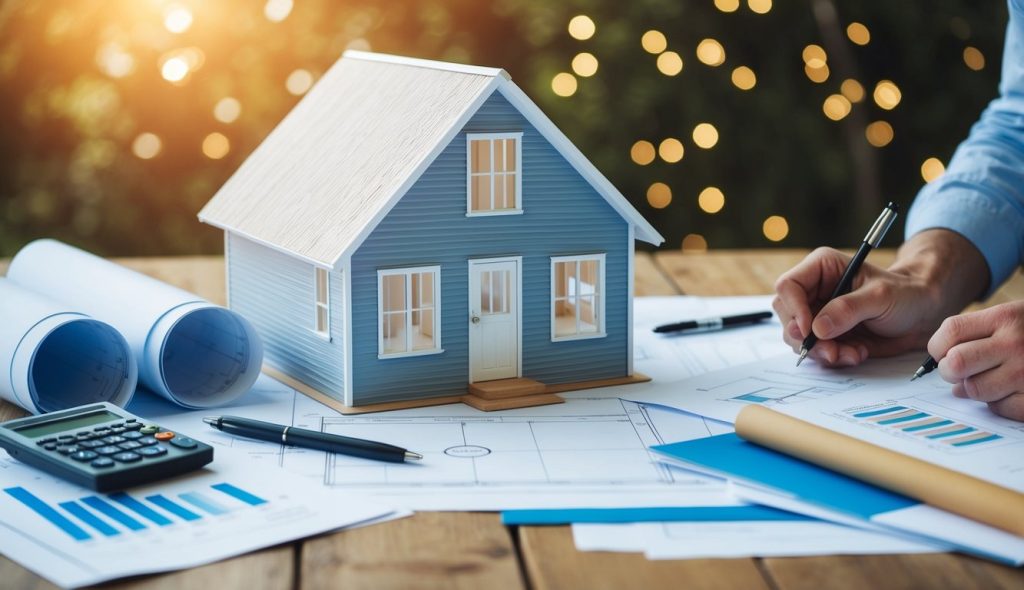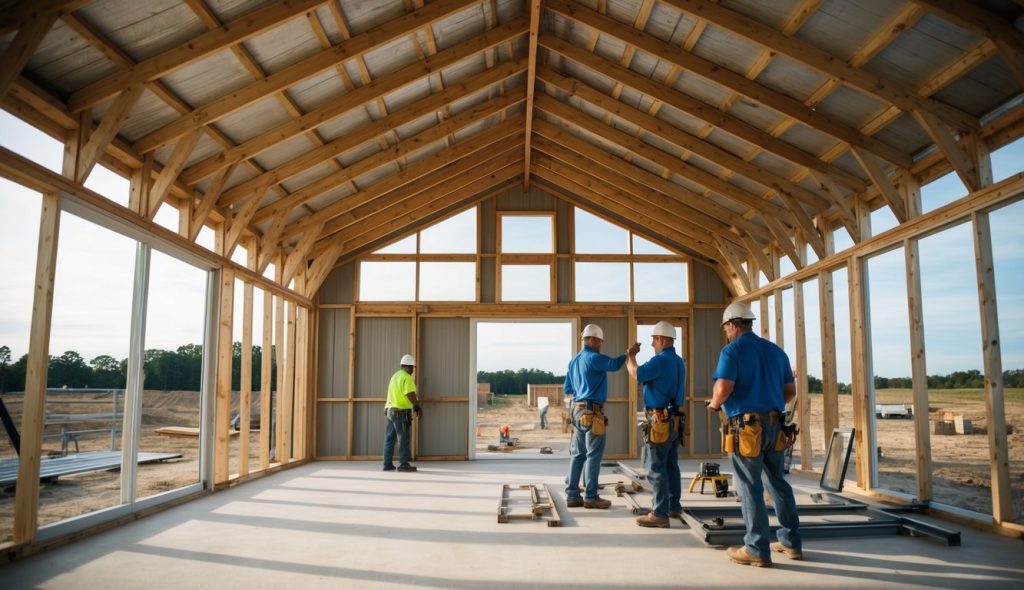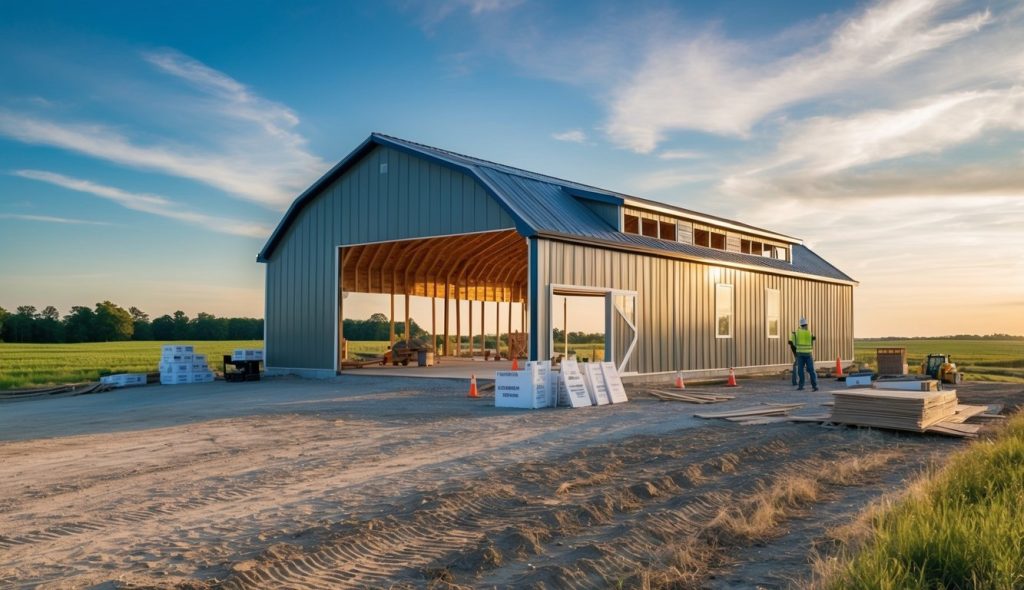Building a barndominium is becoming popular for folks searching for affordable homes.
Barndominiums can be cheaper to build than traditional homes, often resulting in significant savings on initial construction costs.
This hybrid structure not only offers a unique aesthetic but also provides flexibility in design and usage, making it an attractive option for many.

When comparing the costs, it’s important to consider factors like materials, labor, and location.
Some barndominiums can be constructed for as little as $112,800, while others might reach $540,000 depending on customization and features. The average cost for building a barndominium sits around $265,000, which is often less than that of typical stick-built homes.
For those who are curious about the affordability and benefits of barndominiums, exploring this option can reveal valuable insights.
Readers can find ways to budget effectively and enjoy potentially lower long-term costs associated with these unique homes.
Key Takeaways
- Barndominiums can offer significant savings compared to traditional homes.
- Initial construction costs vary widely based on design and custom features.
- Understanding ongoing costs can enhance the overall value of barndominiums.
Understanding Barndominiums

Barndominiums are unique structures that blend the concepts of barns and condominiums. They are becoming more popular as alternatives to traditional homes due to their cost-effectiveness and versatility.
This section will explain what a barndominium is and compare it to traditional homes.
What Is a Barndominium?
A barndominium, often called a “barndo,” is a residential building that typically features metal framing and sheeting, resembling a barn. These structures are designed for both living space and storage, making them highly functional.
Barndominiums can be customized with various layouts and finishes. Many people choose to use barndominium kits, which simplify construction. These kits often include pre-engineered materials that save time and labor costs.
Barndominium vs. Traditional Home
When comparing barndominiums to traditional homes, several factors come into play.
Barndominiums are generally cheaper to build due to lower material costs and simpler designs. The average cost per square foot for a barndo can range from $100 to $200, whereas traditional homes may cost $110 to $170 per square foot.
Barndominiums often offer open floor plans and high ceilings, providing a spacious feeling. In contrast, traditional homes may have more rooms divided by walls, leading to different usage of space. With flexible design options and lower construction costs, barndominiums appeal to many looking for more affordable housing solutions.
Initial Costs and Planning

When considering building a barndominium, understanding initial costs and the planning process is essential. This includes the overall expenses involved in construction and the necessary permits required to start the project.
Average Cost to Build a Barndominium
The average cost to build a barndominium varies widely. Costs can range from $130 to $320 per square foot. For a typical 2,000 square foot barndominium, this amounts to approximately $260,000 to $640,000.
Key factors influencing costs include:
- Materials: Steel frames and siding can affect the overall price.
- Location: Construction costs can vary by region.
- Finishes: Basic versus custom interior finishes can also change the total.
Using a barndominium cost calculator can help estimate specific costs based on individual preferences.
Planning and Permits
Proper planning is crucial in the construction of a barndominium. This includes the overall expenses involved in construction and the necessary permits required to start the project.
The general steps include:
- Research local regulations: Understanding zoning laws is essential.
- Apply for a building permit: This is often required prior to construction.
- Site preparation: Clearing and leveling the land to ensure a solid foundation.
Failing to secure the right permits can lead to delays or complications. Engaging with local authorities early in the process can streamline approvals.
Construction Costs

When considering the costs of building a barndominium, several factors come into play. These include the cost per square foot and labor costs, which can greatly influence the overall budget. Understanding these details can help in making informed decisions.
Cost Per Square Foot Analysis
The cost per square foot for building a barndominium typically ranges from $130 to $320. This variance depends on factors such as location, construction materials, and specific design choices. On average, a 2,000 square foot barndominium may cost between $260,000 and $640,000 to build.
Comparatively, traditional homes often have higher costs, generally between $110 and $170 per square foot. This makes barndominiums potentially more economical. Certain states may have lower costs due to cheaper construction materials or local labor prices, impacting the average costs significantly.
Labor Costs Details
Labor costs can significantly affect the overall expenses of building a barndominium. On average, labor prices can make up about 30% to 50% of the total construction costs.
Skilled labor for barndominiums might be less expensive than for traditional homes, which can help in reducing overall expenses.
Each state can have different labor costs due to local economies and demand for construction workers. For instance, rural areas often have lower labor costs compared to urban centers. Choosing local contractors familiar with barndominiums may lead to more competitive rates and efficient work completion.
Design and Customizability
Barndominiums offer a range of options when it comes to design and customization, allowing homeowners to create spaces that fit their unique needs. From selecting pre-designed plans to making personalized modifications, the possibilities can suit various tastes and budgets.
Selecting Barndominium Plans
Homeowners can choose between stock barndominium plans and custom-designed barndominium plans.
Stock plans are pre-drafted blueprints that simplify the building process and often come at a lower cost. These plans can still be quite flexible, offering various layouts and sizes.
On the other hand, custom-designed plans allow for complete personalization. Such plans cater to specific lifestyle needs and can incorporate unique architectural features. The cost of these plans can vary significantly, depending on complexity and the architect’s fees. Homeowners should assess their budget when deciding which route to take.
Customizations and Modifications
Once a plan is selected, homeowners can consider various customizations. Common options include altering the layout, adding windows, changing roof styles, and selecting materials.
Many builders offer customizable features that allow homeowners to personalize their barndominium further. A few popular options include:
- Open floor plans for spacious living
- Energy-efficient windows for better insulation
- Sustainable materials, which can lower long-term costs
These customizations can impact the overall cost but offer significant value in enhancing comfort and functionality. Balancing personal preferences with budget considerations is key when planning modifications.
Kits and Prefabricated Options
Kits and prefabricated options are gaining popularity among those considering a barndominium. These options can streamline the building process and often reduce costs.
Barndominium Kit Advantages
Barndominium kits offer several benefits for builders.
First, they typically include all necessary materials, which simplifies the purchasing process. Buyers receive the structural components, roofing, and sometimes even interior finishes.
Another advantage is the cost-effectiveness. Barndominium kit prices often range from $70 to $100 per square foot, making them more affordable than traditional homes. Additionally, the kits are designed for easier assembly, which can reduce labor costs.
The versatility of these kits allows for customization, so buyers can create a space tailored to their needs. This flexibility can be appealing for those who value personal style in their homes.
Prefab Kits and Modular Homes
Prefab kits and modular homes provide an alternative to traditional building methods. These structures are factory-built and then transported to the site for assembly. This method can significantly reduce construction time.
Prefab kits often have a fixed price, which helps in budgeting. They can also lead to less waste because materials are pre-measured and cut at the factory.
Additionally, modular homes can include high-quality finishes and modern designs. Many come with energy-efficient options, making them appealing to environmentally conscious buyers. This choice not only helps save money on utility bills but also contributes to sustainable living.
Barndominium Builders and DIY Options
Building a barndominium can be a rewarding experience, whether one chooses to hire a professional builder or take on a DIY project. Each option has distinct benefits, and the choice often depends on budget, skill level, and personal preferences.
Choosing the Right Builder
Finding the right builder is crucial for a successful barndominium project. Builders should have experience specifically with barndominiums to ensure they understand unique design and structural needs.
When searching for a builder, consider these factors:
- Experience: Look for builders who specialize in metal structures and have a strong portfolio.
- Reviews: Check online reviews and ratings from past clients for reliability and quality of work.
- Cost Estimates: Obtain detailed quotes that include materials, labor, and timelines.
- Communication: Choose a builder who communicates clearly and understands the project’s vision.
A knowledgeable builder can help navigate the building process, ensuring that the choice of materials complements the overall design while adhering to local codes and regulations.
DIY Barndominium Projects
For those looking to save money or enjoy hands-on work, a DIY barndominium can be an excellent choice. Planning is essential to avoid costly mistakes.
Key steps in a DIY barndominium project include:
- Research: Gather information on building codes and zoning requirements in the area.
- Planning: Create a detailed blueprint highlighting essential areas like living spaces, storage, and workspaces.
- Material Selection: Choose economical yet durable materials that fit the project budget. Metal frames are often recommended for their strength and affordability.
- Resources: Consider using a barndominium kit, which provides pre-cut materials and instructions, simplifying the building process.
DIY projects demand commitment but can lead to significant savings and a unique living space tailored to personal style.
Cost Efficiency and Savings
When considering the cost efficiency of barndominiums, two main factors stand out: low maintenance needs and energy efficiency. These features can lead to significant savings over time, making barndominiums an appealing option for many builders and homeowners.
Low Maintenance and Durability
Barndominiums, often constructed from steel, are designed to be durable. This means fewer repairs and replacements compared to traditional wood-framed homes.
Steel buildings resist pests, mold, and rot, which are common issues in conventional homes.
Regular maintenance tasks like painting and roofing inspections are simplified. This reduces both time and money spent on upkeep.
Owners may find that they can save hundreds of dollars annually due to the reduced need for repairs and maintenance.
The longevity of steel also adds to its appeal. Many steel structures last for decades, giving homeowners confidence in their investment.
In summary, barndominiums offer a low-maintenance solution that promises durability.
Energy Efficiency Considerations
Energy efficiency is a key factor in the cost-effectiveness of barndominiums. Many of these structures are built with insulation and systems designed to reduce energy consumption.
By incorporating energy-efficient windows, HVAC systems, and smart design, owners can save significantly on utility bills.
Some barndominiums even use renewable energy sources, further decreasing energy costs.
The combination of these features not only maximizes comfort but also contributes to sustainability. This results in a smaller carbon footprint and lower monthly expenses.
As a result, barndominiums can provide a cost-effective living option that prioritizes both energy conservation and comfort.
Financing a Barndominium
Financing a barndominium can present unique challenges and options. It’s important to understand the different methods available for securing funds and the potential hurdles that may arise during the process.
Understanding Financing Options
When considering financing a barndominium, buyers typically have various loan options available. These can include traditional mortgages, FHA loans, and even personal loans.
- Traditional Mortgages: Many lenders offer mortgages for barndominiums once they are classified as a primary dwelling.
- FHA Loans: These government-insured loans can cover homes up to certain limits, making them appealing for many buyers.
- Personal Loans: For those who may not qualify for traditional financing, personal loans might be an option but often come with higher interest rates.
Estimating the total cost for building a barndominium can help determine necessary loan amounts. The average cost lies between $112,800 and $540,000, depending on size and materials.
Barndominium Financing Challenges
Financing a barndominium can prove challenging for various reasons. Many lenders are unfamiliar with barndominiums and may view them as non-traditional homes.
This unfamiliarity can lead to difficulties in obtaining financing. Some lenders may require additional documentation or impose stricter terms.
- Appraisal Issues: Determining the value of a barndominium can be tricky. Appraisers may not have enough comparable sales data.
- Down Payments: Higher down payment requirements might apply, as some lenders consider these homes riskier.
Understanding these challenges can help buyers prepare better when seeking financing options for their barndominium.
Ancillary Costs and Considerations
When building a barndominium, ancillary costs can significantly impact the total budget. Land acquisition and preparation expenses, along with interior finishing costs, are crucial factors to evaluate.
Land Acquisition and Preparation
Land costs vary greatly depending on location, size, and zoning. Buyers need to research these factors closely. Prices can range from a few thousand dollars to over $100,000.
Once land is purchased, preparation is necessary. This can include clearing trees, leveling the ground, and installing utilities. These services add to the construction budget.
Buyers should also consider impact fees set by local governments. These could add several hundred to thousands of dollars to the overall cost. Knowing all these expenses helps in making an informed decision.
Interior Costs and Finishing
Finishing materials play a major role in overall interior costs. Choices can range from basic to high-end options.
For example, flooring, cabinets, and countertops can all vary widely in price.
A typical barndominium might spend between $50 to $100 per square foot on these materials. This means that, for a 2,000-square-foot home, finishing costs can add up to $100,000 or more.
Some owners opt for DIY projects to save money. However, labor costs and craftsmanship can affect long-term results. Therefore, weighing options is essential to avoid overspending and to achieve desired quality.
Long-Term Value and Resale
Barndominiums can offer unique long-term value compared to traditional houses. Their modern design and sturdy construction often attract buyers looking for something different.
The resale value of a barndominium may vary based on several factors, like location, materials used, and market trends.
In general, traditional houses tend to have a more stable resale market. Their classic designs appeal to a wide range of buyers.
When it comes to cost, a barndominium generally falls between $112,800 and $540,000 to build. This can be more affordable than many traditional houses, which average around $158,572 to significantly higher amounts.
Many buyers appreciate the low maintenance that comes with barndominiums, especially if they are built well. This can enhance their appeal in the resale market.
In areas where barndominiums are gaining popularity, their unique style may contribute to a higher resale value. However, they might not be as appealing in regions where traditional homes dominate.
Frequently Asked Questions
This section addresses key queries about the costs related to building a barndominium. These questions include factors that affect costs, comparisons with traditional homes, and how location plays a role in the overall expense.
What factors affect the overall cost of building a barndominium?
Several factors influence the cost of constructing a barndominium. These include the choice of materials, size, complexity of the design, and labor costs.
Custom finishes and additional amenities can also significantly impact the final price.
How do the costs of constructing a barndominium compare with traditional homes?
Barndominiums tend to be cheaper to build than traditional homes. The average cost per square foot for a barndominium is often lower because of simpler structures and less expensive materials.
Building a barndominium can save homeowners a considerable amount compared to conventional housing.
What are the price ranges of barndominium kits currently on the market?
Barndominium kits typically range in price from $20,000 to $100,000 or more, depending on size and included features.
Basic kits might offer essential framing and roofing materials, while more comprehensive ones can include finishes and interior layouts.
How does location influence the cost of building a barndominium?
Location plays a crucial role in the cost of building a barndominium. Prices for land, labor, and materials can vary greatly by region.
Rural areas may provide lower overall costs compared to urban environments, making them ideal for barndominium construction.
What is the average cost per square foot for constructing a barndominium?
The average cost per square foot for constructing a barndominium falls between $130 to $320, depending on various factors like design complexity and local building codes.
This range can fluctuate based on the project’s specific requirements and location.
Can you provide a general cost estimate for building a barndominium of a specific size?
For a standard 2,000 square foot barndominium, costs can range from $260,000 to $640,000.
Factors such as finishes, materials, and whether professionals are hired for construction will affect the total estimate.